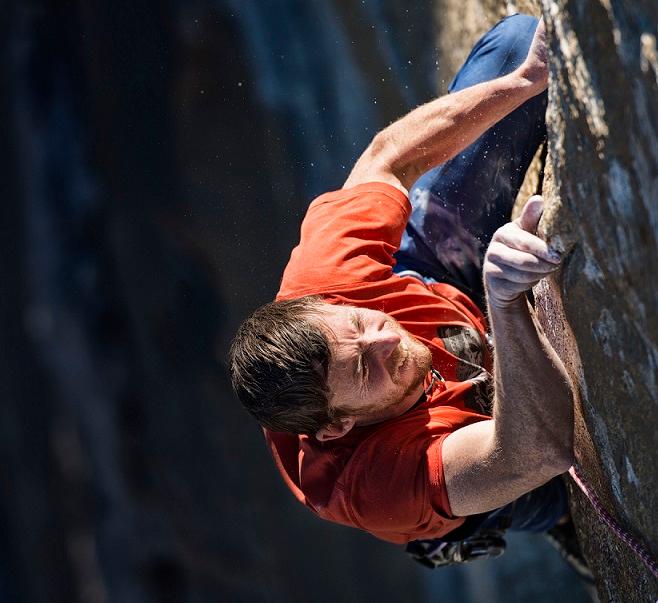

People all over the world stared at the images of climbers Tommy Caldwell and Kevin Jorgeson on the Dawn Wall on Yosemite's El Capitan two years ago, wondering how the two men could do it. They completed the first continuous climb of the Dawn Wall's granite face using only their bodies to propel them, with ropes to catch them if they fell. Outside Magazine called it "arguably the most difficult ascent in the history of rock climbing."

Caldwell's new memoir, "The Push," describes how Caldwell had trained for that feat his whole life. On his third birthday, Caldwell writes, his parents gave him a Superman kite with the requirement that its first flight be from the top of a rock spire in Estes Park, near the family's home in Loveland. So the whole family climbed the rock, with Caldwell scraping his knees on the way up.

Into his teens, Caldwell climbed most often with his dad, Mike Caldwell, a former professional bodybuilder who Tommy describes in the book as "a real-life comic book character." Mike convinced Tommy to enter his first climbing competition at age 16. Although he was an amateur, Tommy beat all the professionals.
It also describes the climber's kidnapping by armed rebels in Kyrgyzstan in 2000, and how Tommy Caldwell freed his group by pushing one of their captors off a cliff. That incident, and a run-in with a table saw during a DIY project at home that cost Caldwell his left index finger, pushed Caldwell in his training and ability to withstand pain.
"The Push" comes out May 16. Caldwell talked about it with Colorado Matters host Ryan Warner.
Related:
- Dawn Wall Climber Tommy Caldwell 'Not Immediately Looking' For A New Challenge
An Insider's View Of Doubts, Triumphs During Historic Ascent Of El Capitan
Read an excerpt of "The Push"
WIND December 30, 2014. Day four, year seven, the Dawn Wall. Twelve hundred vertical feet climbed free, eighteen hundred to go. We hear the wind racing from a half mile away, a roar in the darkness mixed with the pitch of a scream. The volume rises, drowning out all other sounds. We sit like gargoyles, legs stuffed in sleeping bags, backs against the wall. Kevin, my climbing partner, clutches the straps of our hanging tent and forces a smile. I can read his lips: “Hold on tight.” A deafening whap‑a‑pap‑pap resounds with the cadence of a machine gun. It’s just fabric slap- ping the granite, but an involuntary shiver rattles inside me, shaking loose a decade-and-a-half-old memory born from the smell of exploding rock and visions of blood pooling onto the alpine tundra. A sudden updraft swirls beneath the portaledge—our home, roughly the size of a sheet of plywood, with nylon strung between the aluminum frame and draped over its top. The floor begins to lift, and for a moment we hover in space, as if riding a magic carpet. I picture the three-eighths-inch stain- less steel bolt from which we and all of our gear hang. Then the wind abruptly stops and the portaledge crashes down, straps snapping tight. Each morning starts the same. I wake thinking about how to unlock the puzzle above. We brew coffee in our little perch and sit in awe as first light graces us—this part of the monolith of El Capitan, in Yosemite Valley, California, has long been known as the Dawn Wall. I brush my teeth, swish water in my mouth, and poke my head outside. I watch my toothpaste fall as I count one, two, three ... at around ten the white blob disappears into the forest below. I pause and stare at my nine fingertips, cut, raw, but holding together. I often think of how this massive climb hinges on tiny details. Millimeters of skin contact and molecules of healing will make or break our ascent. I gaze across the glacier-carved valley, and to the peaks unfolding on the horizon. I watch falcons tackle swallows in midair. Each day I feel the magnitude of my excitement in my restless legs. It’s strange. In most ways I’m a pretty normal guy—self-conscious, shy at times, awkward. On the wall it's like I come alive; this place changes me. It always has. I take a deep breath and turn to the sheer face rising above. Nobody had ever believed it possible to free climb the Dawn Wall, using only one’s body (primarily fingers and toes) for upward progress, truly climbing, without relying on direct aid from the equipment to hoist oneself up. Legendary figures in the climbing world, some of whom I remember from my childhood, hanging out at our house with my dad, had long wondered if an ascent of El Capitan by any means was even possible. When the first ascent came, in 1958, it was a quantum leap. In subsequent years, countless climbers had made their way to the top following various routes. But freeing the Dawn Wall remained inconceivable. It existed as a kind of “here be dragons” on mental maps of the vertical landscape, virtually featureless and smooth. Because of my father, I’d fallen for climbing long before I’d fallen for anything or anyone else. For me, free climbing the Dawn Wall is an act of purity. Getting to the top under my own power, unaided, is a way to express myself and my love of climbing and life in the grandest form and on the largest scale possible. If successful, and perhaps even if not, I’d validate not only my years of planning, but the entirety of my life. Excerpted from "The Push: A Climber's Journey Of Endurance, Risk, And Going Beyond Limits." With permission from Viking, a division of Penguin Random House. (c) 2017 by Tommy Caldwell. |









